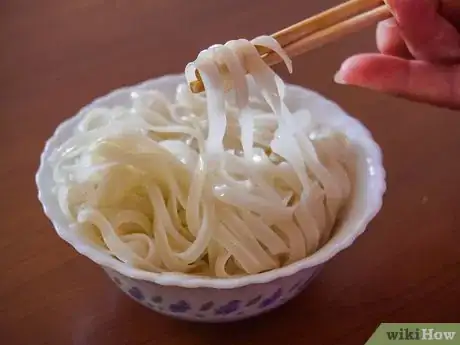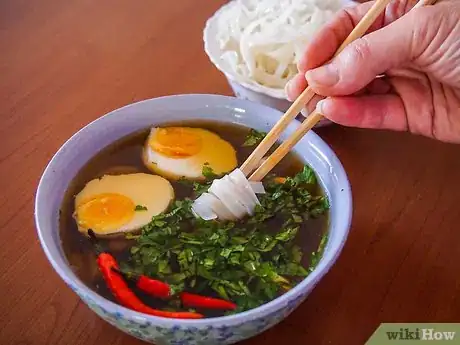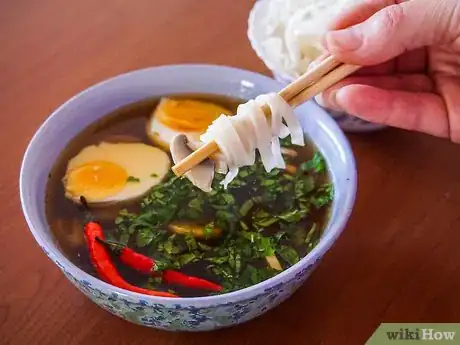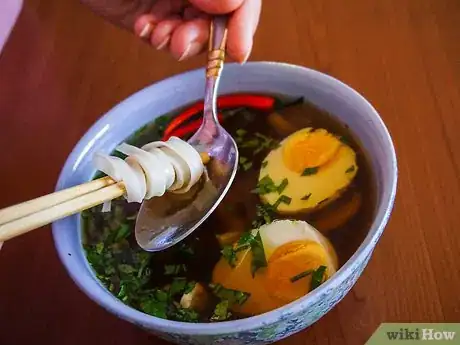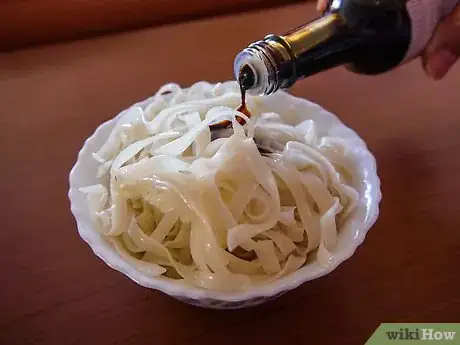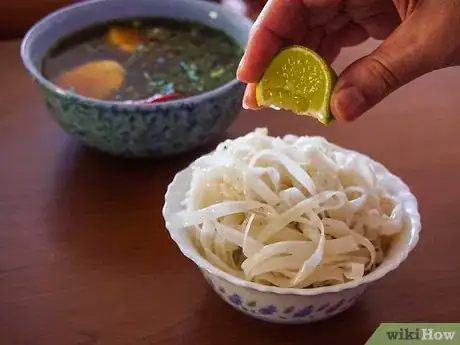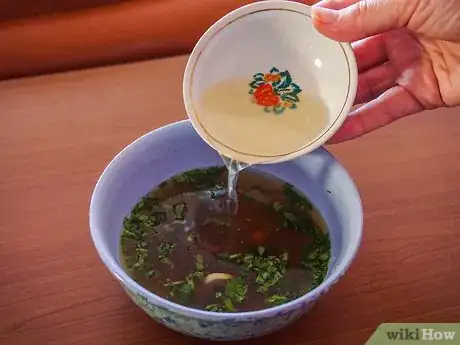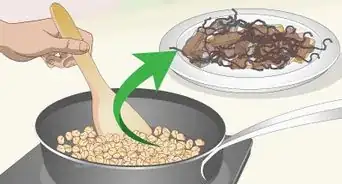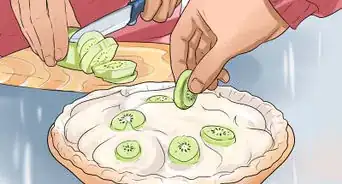X
This article was co-authored by Yoko Isassi and by wikiHow staff writer, Hunter Rising. Yoko Isassi is a Japanese Food Specialist and the Founder of Foodstory in Los Angeles, California. Since 2011, she has taught others how to cook Japanese food and educated others about Japanese food culture. Yoko holds an MA from Columbia University.
This article has been viewed 32,052 times.
Tsukemen, also known as dipping ramen, is a Japanese noodle dish where you dip your food into a hot concentrated broth to add flavor. Though it may seem intimidating at first, tsukemen is an easy dish to enjoy. All you have to do is dunk your noodles in the broth and you’re ready to eat!
Steps
Method 1
Method 1 of 2:
Dipping Your Noodles
-
1Grab a small amount of noodles with your chopsticks. Tsukemen uses thick noodles so the broth can easily stick to them. Pinch 5-6 of the noodles between your chopsticks. Twist your chopsticks as you pick your noodles up to wrap them around one of the sticks. Don’t grab too many noodles at a time or else they may slip out of your grip.
- The noodles will be slippery. Keep practicing with your chopsticks until you can easily pick the noodles up.
- Keep your bowls only 1–2 inches (2.5–5.1 cm) apart so you don’t drop anything on the table.
-
2Dip the noodles in your broth. Tsukemen is typically served with cold noodles, so dunking your noodles completely into the broth will heat them up and give you more flavor. If you want to primarily taste the noodles, only dip them a tiny bit.[1]
- Some tsukemen is served with warm noodles. Ask the restaurant you’re visiting how the noodles are served.
Advertisement -
3Slurp the noodles into your mouth. Bring the noodles to your mouth and suck them in. Don’t worry about making a slurping noise as you eat the noodles since it’s standard in Japanese culture.[2]
- Hold the bowl of broth closer to your mouth if you’re afraid of dropping the noodles or dripping any broth.[3]
-
4Try dipping some the other toppings in your tsukemen. Use your chopsticks to pick up a piece of pork, egg, or whatever else is mixed in with your noodles. Dip the topping into your broth to give it more flavor and to warm it up.[4]
- Wrap noodles around your chopsticks and then pick up another topping to combine the flavors.
-
5Put the noodles in a soup spoon to eat them easily. Grab the noodles with your chopsticks and dip them into your tsukemen broth. Set the noodles in a soup spoon after you’ve dipped them so you don’t have to use your chopsticks anymore.[5]
- Don’t use your spoon to pick up your noodles or sip your broth.
Advertisement
Method 2
Method 2 of 2:
Changing the Flavor of Your Tsukemen
-
1Add condiments to the noodles or broth to add more flavor. Either mix some of the condiments directly into your noodles or stir them into your broth so they’re evenly mixed. Use as little or as much of the condiment as you want, or try mixing a few condiments together to make a new flavor![6]
- If you want to test how a condiment tastes, put a little bit on your spoon to mix with a bite of noodles.
Condiments to Try
• Sriracha
• Chili paste
• Soy sauce -
2Squeeze lime juice onto your noodles for a palate cleanser. Take a lime wedge and squeeze the juice onto your noodles to add a refreshing citrus flavor to your dish. Dip the noodles into your broth to mix all of the flavors together.[7]
- Ask your server for a lime if you don’t already have one on your plate.
-
3Pour dashi stock into the dipping broth if you want to sip it. Dashi broth is a standard fish broth in Japanese cuisine used as a base for miso soup. When you finish your noodles, stir in a small amount of dashi stock to dilute your tsukemen broth. Sip the soup directly from the bowl or use your spoon to drink it.
- Ask your server for dashi stock once you finish your meal.
- Tsukemen broth by itself is too salty and thick to be sipped.[8]
Advertisement
Expert Q&A
-
QuestionAre you supposed to drink tsukemen broth?
 Yoko IsassiYoko Isassi is a Japanese Food Specialist and the Founder of Foodstory in Los Angeles, California. Since 2011, she has taught others how to cook Japanese food and educated others about Japanese food culture. Yoko holds an MA from Columbia University.
Yoko IsassiYoko Isassi is a Japanese Food Specialist and the Founder of Foodstory in Los Angeles, California. Since 2011, she has taught others how to cook Japanese food and educated others about Japanese food culture. Yoko holds an MA from Columbia University.
Japanese Food Specialist Not really. The recipe of the soup often contains nearly double salt compared to that of noodle soup. It is prepared like that since you should only dip your noodles partially or briefly.
Not really. The recipe of the soup often contains nearly double salt compared to that of noodle soup. It is prepared like that since you should only dip your noodles partially or briefly.
Advertisement
References
- ↑ Yoko Isassi. Japanese Food Specialist. Expert Interview. 30 August 2021.
- ↑ https://youtu.be/4Ai6wDEHrT8?t=1m56s
- ↑ Yoko Isassi. Japanese Food Specialist. Expert Interview. 30 August 2021.
- ↑ https://youtu.be/4Ai6wDEHrT8?t=1m56s
- ↑ https://youtu.be/4Ai6wDEHrT8?t=2m40s
- ↑ https://youtu.be/4Ai6wDEHrT8?t=2m27s
- ↑ https://youtu.be/4Ai6wDEHrT8?t=2m50s
- ↑ Yoko Isassi. Japanese Food Specialist. Expert Interview. 30 August 2021.
About This Article
Advertisement
